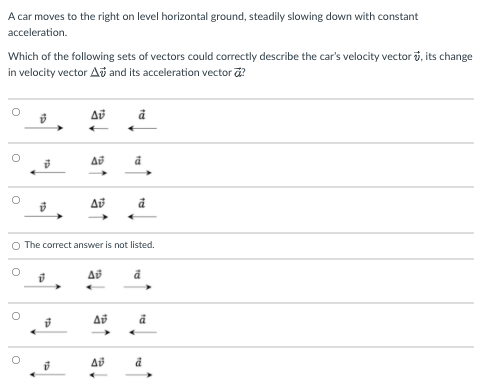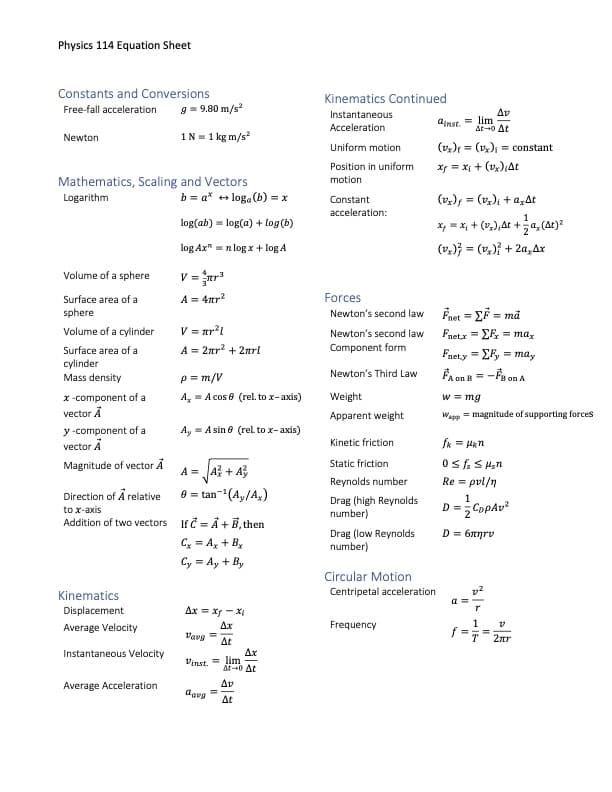A car moves to the right on level horizontal ground, steadily slowing down with constant acceleration. Which of the following sets of vectors could correctly describe the car's velocity vector i, its change in velocity vector Aŭ and its acceleration vector ā O The correct answer is not listed. al at a
A car moves to the right on level horizontal ground, steadily slowing down with constant acceleration. Which of the following sets of vectors could correctly describe the car's velocity vector i, its change in velocity vector Aŭ and its acceleration vector ā O The correct answer is not listed. al at a
University Physics Volume 1
18th Edition
ISBN:9781938168277
Author:William Moebs, Samuel J. Ling, Jeff Sanny
Publisher:William Moebs, Samuel J. Ling, Jeff Sanny
Chapter2: Vectors
Section: Chapter Questions
Problem 63P: Assuming the +x-axis is horizontal to the right for the vectors in the preceding figure, find (a)...
Related questions
Question
Question 21, Physics - equation sheet attached

Transcribed Image Text:A car moves to the right on level horizontal ground, steadily slowing down with constant
acceleration.
Which of the following sets of vectors could correctly describe the car's velocity vector 5, its change
in velocity vector Að and its acceleration vector ā?
O The correct answer is not listed.

Transcribed Image Text:Physics 114 Equation Sheet
Constants and Conversions
Kinematics Continued
g = 9.80 m/s
Free-fall acceleration
Δν
Instantaneous
ainst. = lim
At-o At
Acceleration
1N = 1 kg m/s?
Newton
Uniform motion
(v) = (v); = constant
Position in uniform
X = x + (v)At
Mathematics, Scaling and Vectors
b = a* + loga (b) = x
motion
Logarithm
Constant
(v); = (v,); + azAt
acceleration:
1
log(ab) = log(a) + log (b)
x, = x, + (v,),At +a, (at)?
log Ax" = n log x + log A
(v,); = (v,)} + 2a,Ax
Volume of a sphere
V =
Surface area of a
A = 4ar?
Forces
sphere
Newton's second law
Fnet = EF = mã
%3D
Volume of a cylinder
V = arl
Newton's second law
Fnetx = EF = ma,
%3D
Surface area of a
A = 2ar? + 2rl
Component form
Fnety = ER, = may
cylinder
Mass density
p = m/V
Newton's Third Law
FA en =-
ton A
A, = A cos e (rel. to x-axis)
Weight
w = mg
x -component of a
vector Å
Apparent weight
Wapp = magnitude of supporting forces
y -component of a
Ay = A sin 8 (rel to x-axis)
vector Å
Kinetic friction
fk = Han
Magnitude of vector Ả
Static friction
A = JA + A,
Reynolds number
Re = pvl/n
Direction of A relative
8 = tan-(Ay/A,)
1
Drag (high Reynolds
number)
=CopAv?
to x-axis
Addition of two vectors If = Å + B, then
C, = A, + B,
D = 6nyrv
Drag (low Reynolds
number)
Cy = Ay + By
Circular Motion
Kinematics
Centripetal acceleration
a =
Displacement
Ax = x - X
Average Velocity
Ax
Frequency
1
Varg
T
2ar
At
Ax
Vinst. = lim
Instantaneous Velocity
At+0 At
Av
Average Acceleration
davg
Δε
Expert Solution
Step 1
Step by step
Solved in 2 steps

Knowledge Booster
Learn more about
Need a deep-dive on the concept behind this application? Look no further. Learn more about this topic, physics and related others by exploring similar questions and additional content below.Recommended textbooks for you

University Physics Volume 1
Physics
ISBN:
9781938168277
Author:
William Moebs, Samuel J. Ling, Jeff Sanny
Publisher:
OpenStax - Rice University

Principles of Physics: A Calculus-Based Text
Physics
ISBN:
9781133104261
Author:
Raymond A. Serway, John W. Jewett
Publisher:
Cengage Learning

Classical Dynamics of Particles and Systems
Physics
ISBN:
9780534408961
Author:
Stephen T. Thornton, Jerry B. Marion
Publisher:
Cengage Learning

University Physics Volume 1
Physics
ISBN:
9781938168277
Author:
William Moebs, Samuel J. Ling, Jeff Sanny
Publisher:
OpenStax - Rice University

Principles of Physics: A Calculus-Based Text
Physics
ISBN:
9781133104261
Author:
Raymond A. Serway, John W. Jewett
Publisher:
Cengage Learning

Classical Dynamics of Particles and Systems
Physics
ISBN:
9780534408961
Author:
Stephen T. Thornton, Jerry B. Marion
Publisher:
Cengage Learning